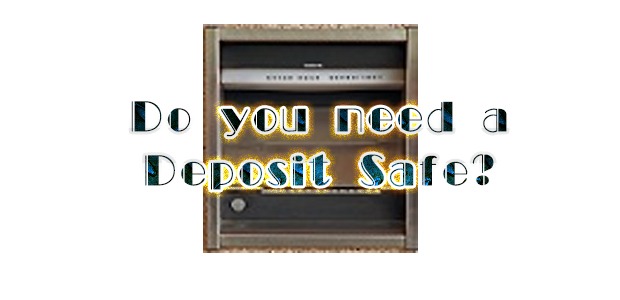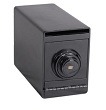A deposit Safe can have several names including drop safe and depository safe. These safes utilize a drop door or drop slot that allows a person to place an item (keys, cash, reports, etc.) inside the safe without them having the combination or keys. This type of safe is very common in commercial locations such as restaurants, gas stations and other places that bring in a lot of money that needs to be secured.
There are several types of safe in this category.
 Slot Deposit Safes
Slot Deposit Safes
Slot style deposit safes are usually a small safe less than one foot square. This type of safe usually has a slot in it just large enough to receive a thin envelope. The envelope is placed into the slot and usually will pass by several anti-fish baffles. These baffles are jagged edged sheets of metal designed to prevent people from placing items in the slot and fishing the money or envelopes out. These safes can be secured by a combination lock, an electronic lock or a key lock. The key lock models of these safes are popular as they are economic and effective.
 Drop Door Depository Safes
Drop Door Depository Safes
The drop door type of safe utilizes a door that opens and items can be placed inside. When the door is closed the items fall into the lower portion of the safe and are protected by anti-fish baffles. Most of these are large enough for item such as keys, bank bags and large envelopes. The size of these safes vary greatly from small economic models to large models with 2 doors and 3 shift drops. These safes utilize all three types of locks and usually have group II combination locks standard.
 Rotary Hopper Deposit Safe
Rotary Hopper Deposit Safe
This type of safe has an open area on the top. Directly below the open area is a cylinder with an open area in it. The cylinder has a handle and can be rotated around in a circle horizontally. When the hole in the cylinder and the hole in the top of the safe are aligned, you can drop items into the cylinder. When the cylinder is turned and the hole reaches the bottom of the cylinder, the item is dropped into the bottom area of the safe. These safes usually also have anti-fish baffles and come in a variety of sizes and shapes. All three lock types are available for these safes.
 Bank Depository
Bank Depository
These are primarily use at banks. There is an outer door that usually is on the outside of a building and it can be opened with a user key so items can be dropped inside. When the door is closed the deposit will pass through a more complicated security/anti-fish system then finally fall into a safe on the inside of the building. The interior safe is usually a UL Rated High Security Safe with a Group II or Group IIR combination lock. This type of drop safe is very expensive and not common in retail.
Most deposit safes are not made for overnight protection of deposits. Of course bank depository safes are, but when utilizing one of the other safes for night deposits you may also want to consider an alarm system so a burglar has minimal time inside to gain access to your safe. For overnight use I highly recommend a safe that has a ½” door and 1/4” body construction or larger.


 Slot Deposit Safes
Slot Deposit Safes  Drop Door Depository Safes
Drop Door Depository Safes  Rotary Hopper Deposit Safe
Rotary Hopper Deposit Safe  Bank Depository
Bank Depository